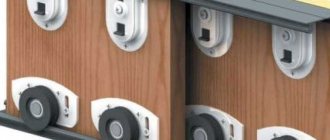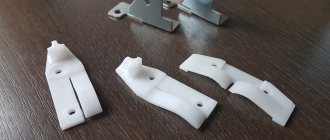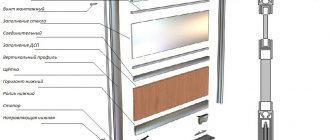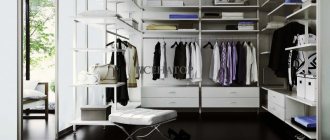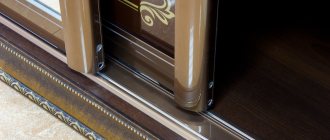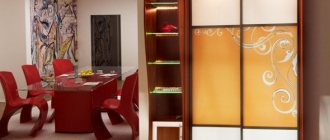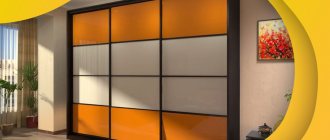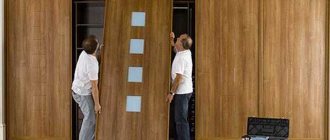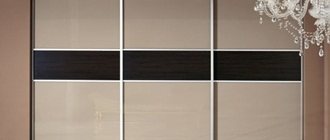What size can you make a closet?
When making calculations, first of all, they proceed from the size of the room or part of the space (say, a corridor or hallway) that they decided to allocate for a built-in closet.
However, there are several significant aspects that need to be taken into account. Depth The standard depth of a wardrobe with hinged doors is 60 cm. This is enough for hangers with clothes to fit freely on a regular longitudinal rod: for a convenient arrangement of outerwear, at least 55 cm is required, for light clothing - 5 cm less. If it is a closet with sliding doors, you need to add another 10 cm - that’s how much the “compartment” design will “eat”. Width The minimum width of the cabinet is not regulated, but there is no point in making it less than 40 cm - otherwise boxes with shoes will not fit.
In a cabinet with a depth of less than 50 cm, you will have to replace the longitudinal rod with end rods. Calculate their number correctly: on average, 8 hangers are placed on a 40-centimeter end rod.
Non-standard dimensions
Any design whose dimensions differ from the standard ones is considered non-standard. In order for the product to fit harmoniously into the room and not cause inconvenience during operation, you need to draw up a competent diagram. The best option in this case is to call a specialist to your home, who, based on the expected location and taking into account the wishes of the owners, will calculate the ideal design parameters. This tactic minimizes the likelihood of errors, which is very important, since the production of custom-made furniture is always associated with high costs.
Tips for choosing guides for sliding wardrobes, installation features
The non-standard category includes, for example, furniture with a depth of less than 45 cm and more than 50 cm. The use of special materials is not required for its manufacture. When creating a model of a future cabinet of a non-standard size, it is recommended to be guided by the following rules:
- the width of the doors should not exceed 1 m, otherwise the roller system will have to withstand increased load, which will cause rapid breakdown;
- if the depth of the structure does not exceed 40 cm, and the width of the doors is about 100 cm, it is recommended to equip the attribute with an additional pair of rollers.
Review of modern wardrobes, classification of models, advice on selection
How to plan the interior space of a closet?
Designers recommend that before planning your closet, make a list of all the things that you will store in it, and then add another 20% “for the growth of your wardrobe.” Decide what will go on the shelf or in baskets (knitwear) and what will hang (pants, jackets). And how many things do you have in each category? Decide on the price: the internal filling of the cabinet can vary greatly in cost. Therefore, limit the budget you plan to meet in advance.
Longitudinal and end rods
Clothes hanging on hangers will take up the largest compartments. For women's clothing, we plan a box with a height of 150-160 cm. If long men's coats or raincoats will hang in the closet, set a height of 175 cm. Estimate at least approximately the number of items of clothing that will hang on hangers. You can put 5 cm on each hanger - this will be the width of the compartment (and the length of the longitudinal rod).
If you have a narrow closet with end rods, allow 60 cm of the width of the compartment on each hanger. There are usually not many end hangers - 2-3 pieces. Sometimes it’s worth making separate boxes with a bar for short items: skirts, trousers, shirts and blouses. They require a smaller height - 80-100 cm, which means they save space.
If men's trousers are hung without bending, allow 120 cm in height for them.
If you require a longitudinal rod length of more than 120 cm, provide a vertical support rod in the middle. It is positioned between the upper and lower partitions and is connected to the horizontal rod with a special coupling. This is necessary so that the longitudinal rod does not bend under the weight of things. If heavy things are hanging on hangers - fur coats, coats - the length of the bar without support should not exceed 100 cm.
Another important nuance: if the wardrobe is not built into a niche, but has side walls, do not plan a compartment with a rod immediately behind the outer wall. Make better ordinary horizontal shelves there. Sliding doors, rolling back and forth, push the side wall, creating an impact load. Horizontal shelves located close to the side plate will connect it with the rest of the supporting structures of the cabinet. One barbell will not provide such a strong connection.
Bar with lift (pantograph)
A pantograph is a special device that allows you to lower and raise a barbell. Such designs are quite expensive, but are indispensable in tall cabinets when you have to use space right under the ceiling. The pantograph will lower jackets and skirts directly into your hands, and then again remove the bar with things to an unattainable height.
Shelves Built-in wardrobes are ordered not only for clothes. On open shelves you can store almost everything (except for what needs to be hung): bed linen and knitwear, books and dishes. For clothes, you can use long shelves (80-120 cm), and for heavy books and dishes, the length of the shelf should not exceed 80 cm. A convenient distance between shelves is at least 40 cm.
If you are making a shelf longer than 80 cm, provide a vertical partition underneath it as additional support. Otherwise, the shelf may bend during use. In addition, the shelves are suitable for storing neatly folded jeans, bags, jewelry boxes, and hats. So make more shelves - they will all come in handy.
Special shelves
Wide shelves are designed at the top of the closet for blankets, rugs and bed linen. In addition, it would be nice to provide compartments for sports equipment. Think about what exactly you will store there. Four pairs of roller skates? Tennis rocket? Yoga mat? It is better to measure especially large devices in advance. At this moment you understand the advantage of a chess player over a bodybuilder. In addition, at the very top there is usually a large long shelf for suitcases, bags and travel equipment. Height - 45-50 cm.
Size options
The first criterion that is taken into account when purchasing new furniture is its dimensions. In order not to be disappointed later, you should think about the interior features. Let’s say that installing any other furniture will be impossible if you purchase a cabinet that occupies all the free space.
Standard
There are no basic sizes of sliding wardrobes as such. More often, such elements are made to order; the dimensions directly depend on the specifics of the room and location. However, when creating projects and deciding on sizes, you should adhere to the following recommendations:
- The standard height of the base is 8 cm.
- The maximum height of sliding wardrobes is 250 cm, this is due to the fact that chipboard and other boards do not come in large sizes. But since in many apartments the distance from floor to ceiling does not exceed 235 cm, such structures are usually made even lower - about 220 cm.
- If we consider the width, then it is influenced by the placement of the structure. When the attribute is installed in the corner of the room, usually this parameter does not exceed 160–180 cm. If the closet is placed along the entire wall, its width can reach 3 m. It is worth considering that wide models are more convenient, since it is convenient to store not only clothes in them, but also shoes, sports equipment, dishes, bed linen.
- The depth of the furniture according to GOST is at least 45 cm. If the value is less, the model is considered non-standard. In general, the optimal depth of wardrobes is 50 cm.
- The space between the shelves is 30 cm, their width is 100 cm.
How to adjust wardrobe doors yourself at home
In order for the structure to look harmonious, it is desirable that it reaches the ceiling. In this case, the space will be used as rationally as possible. A sliding wardrobe of standard sizes is universal - such an attribute can be placed in any room.
If the room has a suspended ceiling, the distance to the plane of the cabinet must be at least 50 cm, otherwise the craftsmen will not be able to repair the ceiling if necessary.
Mini
Designs with small dimensions will be an ideal solution for small-sized apartments, where every square meter is valued. It is also impossible to say what the standard parameter will be in this case, since everything depends on the area and shape of the room and its purpose. When manufacturing miniature cabinets, the following features are taken into account:
- The minimum width is 100 cm. Cabinet doors cannot be less than 45 cm. If they are narrower, opening and closing will be difficult, and the design will be unreliable. In addition, if the doors are less than 45 cm, they will constantly fall out.
- The minimum depth of sliding wardrobes is 35 cm. It is worth considering that the size of the shelves in this case will not exceed 25 cm, so they can accommodate a minimum number of things. If the depth of the cabinet is even smaller, the structure will be unstable.
- The height of the attribute is selected taking into account the wishes of the customer, everything depends only on the ceiling.
If there are no other options, you can order a structure with a depth of less than 35 cm. Such models are usually created for specific needs. But since such cabinets are unstable, it is recommended to additionally fasten them to the wall using special clamps.
Maxi
A large sliding wardrobe is suitable for spacious rooms with an area of at least 20 square meters. m. The most suitable place for their placement is considered to be bedrooms or living rooms. Such structures replace dressing rooms; they can also be used to store sports equipment, bedding, and dishes.
Character traits:
- If in standard sliding wardrobes the depth is 40 cm, then in similar designs it reaches 90 cm. The maximum number of things can be placed on the shelves, but you need to understand that not everyone will be comfortable using them. The arm length of an adult, as a rule, does not exceed 60 cm, so the optimal shelf depth is 50 cm.
- The height of such a product does not exceed 250 cm, since this is the standard size of a chipboard sheet. When it is necessary for the structure to be even higher, mezzanines are added on top. In addition, if the cabinet is taller, it will be inconvenient to use.
- The optimal width of a large wardrobe is 3 m. If the parameter needs to be increased, partitions are added to the drawing.
- The maximum possible length of the guides is 5 m, while the width of the door cannot exceed 1 m. Accordingly, there can be no more than 5 doors.
How well the structure will function and how long it will last largely depends on the drawing. That is why the scheme should be developed by a professional with extensive experience. If the cabinet drawing is incorrect, the attribute may not be usable.
How to keep your shelves tidy?
Clothes can slide off shallow shelves, but on long shelves they quickly turn into a shapeless heap. To prevent this from happening, make small shelves with a side or divide a long rack into separate square cells: this way, each stack of clothes will have its own cell. Maintaining order will become much easier. Another way to organize the contents of open shelves is to put everything in boxes.
Roll-out shelves
Roll-out shelves are more convenient than fixed ones - they make it easy to find and get what you need. And the distance between them may be less than between ordinary ones. True, convenience does not come cheap.
Drawers Drawers are also much more convenient than their stationary counterparts - they allow you to easily view the contents. And besides, they save cabinet space: the height of a standard drawer is 20-25 cm, the height of a shelf is 35-40 cm. The drawers better protect the contents from dust. They have one downside - they cost significantly more than shelves, so it makes sense to use them locally: for all sorts of small things that are inconvenient or impractical to store on shelves: hats, gloves, scarves and other accessories. For stockings, socks and underwear, shallow drawers are used - about 12 cm high. The most convenient drawer models are those with a transparent front wall. They allow you to see the contents of the drawer without pulling it out.
When designing a drawer and calculating its width, be sure to take into account the width of hinges on swing doors and door joints in wardrobes. If the drawer is made to the full width to the maximum, it may simply not slide out.
Organizers Drawer dividers and organizers help prevent chaos. They can be built into the box, or they can be sold separately from it. If you hate piled-up laundry, it’s better to invest in this additional option and enjoy putting your socks into bins. Like solitaire.
How to store shoes? Special inclined shoe shelves are a very convenient way to store shoes and boots. Alas, such shelves are not very spacious. It is more rational to divide shoes into two parts: those that are worn now, and those that need to be stored - seasonal, elegant, for special occasions. Leave what you need on the shelves, and put the rest in boxes and put them in the far corners of the closet. Shoe shelves are usually designed at the bottom of the closet. Their standard length is 80-100 cm.
If shoes and bags play an important role in your life, you can allocate each item a separate place in the closet.
How to properly arrange a mezzanine?
Mezzanine is a separate space at the top of the cabinet. It’s not so easy to get there, so basically the mezzanine functions as a storage room: seasonal items and sports equipment, suitcases and dresses that “I’ll wear when I lose weight” are put away here. Inside the mezzanine, as a rule, there are no additional compartments and drawers. If the height of the cabinet allows it, you should not add separate doors to the mezzanine - this will only increase the cost of the cabinet. A separate sliding door will be especially expensive, so if you have to, it’s better to make it hinged or folding.
Sliding wardrobe: standard and non-standard
To create such a functional device in any room, you can go in three ways. Making it to order is both simple and convenient. Master manufacturers will adjust the wardrobe down to the centimeter and will implement any project if you find a qualified manufacturer with a good reputation.
Bedroom closet height
However, this is a very expensive allowance, since you also need good material for manufacturing and quality fittings appropriate for the occasion. There are still a few possible options left:
- The second, in everyone’s opinion, cheaper way is to assemble it with your own hands from scrap materials. The facade and fittings can be purchased at Leroy Merlin, and for the base you can use an existing hinged wardrobe, which has lost its presentability, but is still strong. Then the height of the cabinet will depend on the existing dimensions. But if the roof is strong enough, you can always make a mezzanine or an additional shelf with the same sliding doors on the wardrobe structure.
- As an option, you can purchase chipboard or fibreboard, fittings and decor (you can pick them up at Leroy Merlin), and beautiful mirrors – even at Ikea. But all this is a good option if a person can independently calculate the sizes. This can be done in software on a computer or manually, on banal graph paper. Then you should cut according to the calculations made and assemble the structure so that it is not only functional, but also aesthetic.
Maximum ceiling height
The third way involves a certain symbiosis of the two listed - to purchase a finished product, assemble it with your own hands and creatively rework it if there are inconsistencies with the requirements for furniture.
When it is needed not for the royal chambers, built according to an individual project, with vintage staircases, five-meter ceilings and French windows, you can quite easily select the necessary thing.
This happens because manufacturers mainly focus on the mass consumer. All ready-made sliding wardrobes are designed for standard apartments in high-rise or five-story buildings. After all, they still make up the majority of buyers who need additional space.
Children's wardrobe dimensions
For owners of their own homes, with their individual projects, the optimal path is to master manufacturers.
Sliding wardrobe or wardrobe with hinged doors?
It is not necessary to hide the contents of the sections behind large monolithic doors.
Each section and block can have its own separate swing doors. In this case, the drawers will become part of the facade. You will get quick access to things, and the front will look more interesting - if, of course, you have planned the design aesthetically. Shelves and drawers hidden behind large doors can be arranged based solely on logic rather than aesthetics. Additionally, keep in mind that wardrobe doors “eat up” 10 cm of space, while a hinged door is only the thickness of a chipboard or MDF board (10 or 18 mm).
And most importantly, solid facades will cost less.
Types of coating for hinged cabinet facades
There are different options for the final finishing of facades. This allows designers to find new solutions, and buyers to choose a product that best suits the rest of the interior.
- Pasting with PVC film is the most budget option. There is a wide palette of shades and textures.
- Acrylic dyes allow you to achieve unusual effects: pearlescent, glossy or matte surfaces. A protective layer of varnish is applied on top.
- Decorating with plastic does not burden the doors and makes it possible to add bright accents to the interior. High-quality material is highly durable and does not require special care.
- Veneering facades made of MDF or chipboard imitates natural wood, but has an affordable price and less weight.
- Glass is decorated using different techniques: sandblasting, fusing, matting, stained glass, colored varnish.
- Mirror surfaces can visually expand the boundaries of a room and make it brighter. They are complemented with colored inserts, carvings, etc.
- Leather, matched to the color of upholstered furniture made of the same material, will create a harmonious environment, and it is also practical.
- Unique design can be achieved using photo printing. The selection of images can satisfy any request.
Mirror, plinth and lighting
Mirror The most popular way to place a mirror in a closet is to make the doors mirrored. You can cover the closet with mirrors completely or partially. It is ergonomic: the mirror does not take up additional space, and reflective surfaces add shine, light and volume to the interior. If you are not a fan of large mirror surfaces in the interior, mirror the inner surfaces of the doors. True, this method is only suitable for swing structures. Two open doors with mirrors inside will provide the effect of a dressing table: you can see yourself both in front and behind.
Base This element of a built-in wardrobe is useful if you have an uneven floor, which means there may be problems with doors mounted to the very bottom. Coupe doors will slide downhill, and you won’t be able to install a guide on bumps. Swinging doors can also warp, in addition, there will be unsightly gaps between the door and the floor. The plinth allows you to level the lower level of the cabinet, eliminating these problems.
Lighting Additional lighting of the closet is effective, practical, but not at all necessary. Using lighting, you can make open shelves more interesting and the space behind glass doors more mysterious. After all, illuminated shelves make it easier to find what you need. Mounting lighting inside sections makes sense if you have open shelves and want a beautiful decorative effect. Lighting hidden inside one shelf will not reach another compartment. If you want to illuminate the contents of the closet so as not to rummage through things in the dark, install lamps in the canopy. Don't forget to leave a gap between the canopy and the top border of the swing doors so they don't get caught. The transformer for built-in lamps is usually installed on the roof of the cabinet.
Doors for hinged wardrobes
Depending on the number of sashes, all models are divided into several types.
The most common is the double-leaf wardrobe. It is suitable for small rooms; its rectangular shape without any frills does not require much space for installation.
The most modest dimensions have a single-door design or, in other words, a pencil case.
It is advisable to install products equipped with 3 or 4 doors in spacious rooms. They can be equipped with mezzanines on top, which increases their capacity.
A five-door wardrobe is essentially a mini dressing room. To install it, you must have enough free space. Otherwise it will look too bulky.
There are standards that determine the dimensions of the doors in a swing structure.
The maximum length is 2.5–2.7 m.
A width of less than 30 cm does not add attractiveness to the product. The optimal interval is considered to be from 40 to 50 cm. The maximum value should not exceed 65 cm. Otherwise, the load on the fittings increases, which can cause distortion and destruction of the door leaf.
The design distinguishes between solid and frame facades.
The first type is a canvas made of one material. Used in production:
- natural wood;
- MDF;
- Chipboard.
Frame facades have great potential. Their design consists of a frame and a panel. A thin sheet is inserted into the frame, which is fixed in special grooves using glazing beads. They are attached with nails or glue. MDF, natural wood or aluminum are used for framing. Inserts are made from any types of materials used in furniture production.
This design option has a number of advantages:
- reduced weight;
- variety of decoration;
- efficiency;
- combination of several materials.
How can you reduce the cost of a built-in wardrobe?
Reducing the price of a cabinet is, of course, a way of compromises, but not all of them will be painful for you. So what can you give up? If you are planning a wardrobe, replace the expensive aluminum system with a cheap steel one. It is, of course, less reliable, but if you do not look too far ahead, it will do just fine. The service life of an aluminum system is 20 years, while that of a steel system is on average 5-7. Well, the steel one is noisier. Another saving resource is the number and design of doors. If you replace narrow doors with fewer wide ones, it will be cheaper. In some places you can abandon doors altogether - make a combined façade with open shelves or install hinged doors instead of compartment doors.
You can reduce the cost of a cabinet by using the materials used. Instead of the expensive chipboard that goes on the facade, use a white or thinner board inside. It is usually significantly cheaper. If you plan the shelves correctly, their load-bearing capacity will not deteriorate. Full-extension drawers are convenient, but quite expensive. You can replace ball bearing guides with roller guides. Yes, the drawers will not slide as smoothly and they will not be able to be pulled out completely, but this is not always important. Or give up drawers in favor of regular shelves.
You can save on shelf fastenings. Instead of invisible eccentrics that pull shelves and sides together, use regular corners. In essence, there are no inconveniences from them - on the contrary: if you want, you can rearrange the shelves differently. The only case when it is impossible to refuse eccentrics is when the shelves serve as stiffening ribs that hold the cabinet structure, for example, in the outer section with an open, non-built-in side panel.
Information provided by the site mebeldok.com
Design and types of fittings for swing doors for a closet
For normal operation of the swing system, high-quality fittings are required. It is the key to long-term use of such products. The main elements are hinges, from which a high margin of safety is required. The choice depends on the size of the cabinet, the material used, and the weight of the doors.
The classification is based on the principle of placing the door on the hinge body.
- When closed, the overhead fittings are tightly pressed to the end part. The doors in this state completely hide the furniture body.
- The semi-overlay type is used when 2 facades are hung on one side stand at once. The loop has a slight bend, which ensures this arrangement.
- Inset hinges resemble the previous type, but their base bend is greater. Their task is to place the façade inside the building.
- Corner elements are necessary to secure the doors in corner cabinets.
- The inverse view allows the doors to open 180°.
- Piano hinges are considered obsolete and are almost never used due to low reliability.
- The card-type fittings are similar to the previous design. They are installed on furniture made in retro style. You can often find products of unusual shapes to enhance the decorative effect.
- Adit hinges are used for hanging sashes to false facades or “blind” walls.
- The heel mechanism is installed in the corners of the door at the bottom and top. This type is not able to withstand heavy weight, so they are used for facades made of lightweight materials.
Depending on the size and weight of the door leaf, the required number of hinges is calculated. For lengths up to 1 m, 2 pieces are sufficient. Increasing the parameter will require installing an additional part in the middle of the sash.
As for weight, starting from 9 kg, one more loop is added. It is believed that an increase in weight of 5 kg requires additional fastening. Screws are used to secure the fittings.
Dimensions of internal elements and body of sliding wardrobes
A cabinet cabinet, in addition to the internal filling elements, implies the presence of a base, that is: walls, a podium and a ceiling of the cabinet. Furniture manufacturers produce structures based on standard apartment sizes. Sliding wardrobes have the following standard sizes:
- height varies from 220 cm to 240 cm;
- depth from 45 cm to 60 cm;
- optimal width from 90 cm to 240 cm;
- the depth of the shelves depends on the depth of the cabinet; if the cabinet has a depth of 65 cm, then the depth of the shelf should not be more than 50 cm;
- distance between shelves from 30 cm to 36 cm;
- section width - maximum 90 cm;
- The width of sliding doors ranges from 45 cm to a meter.
The height of the wardrobe affects the presence of a mezzanine. If the height is more than 270 cm, then the spacious mezzanine is equipped with personal sliding doors.
The drawing below of the sliding wardrobe clearly demonstrates the dimensions of the compartments and their purpose.
Drawing of a sliding wardrobe with dimensions of the body and internal elements
How to choose a project or option
Maximum attention is usually paid to depth and width. This is necessary so that clothes do not rub and it is convenient to reach with your hands, as well as hang hangers or fold blankets. You need to know how to fit into the surrounding space and not create non-functional compartments. But height is an equally important parameter if a non-standard option is planned.
Wardrobe with mirror front
An incorrectly calculated load on the plinth, created by mezzanines or drawers, can lead to an immediate distortion of the structure, causing the doors to stop moving easily. And ease of use also matters - both in the heaviness of the door and in the ability to easily get the necessary items.
